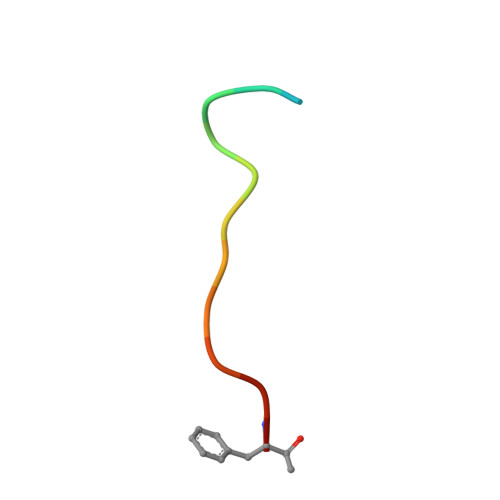Navigation Inside a Protease: Substrate Selection and Product Exit in the Tricorn Protease from Thermoplasma acidophilum
Kim, J.-S., Groll, M., Musiol, H.-J., Behrendt, R., Kaiser, M., Moroder, L., Huber, R., Brandstetter, H.(2002) J Mol Biol 324: 1041-1050
- PubMed: 12470958
- DOI: https://doi.org/10.1016/s0022-2836(02)01153-1
- Primary Citation of Related Structures:
1N6D, 1N6E, 1N6F - PubMed Abstract:
The proposed pathway and mechanism of substrate entry and product egress in the hexameric D3 symmetric tricorn protease from Thermoplasma acidophilum were explored by crystallographic studies of ligand complexes and by structure-based mutagenesis. Obstruction of the pore within the 7-bladed beta-propeller (beta7) domain by alkylation or oxidation of an engineered double cysteine mutant strongly decreased enzymatic activities. In line herewith, the crystal structure of the tricorn protease in complex with a trideca-peptide inhibitor modifying the catalytic Ser965 revealed part of the peptide trapped inside the channel of the beta7 domain. The cysteine mutation widening the lumen of the 6-bladed beta-propeller (beta6) domain enhanced catalytic activity, which was restored to normal values after its alkylation. A charge reversal mutant at the putative anchor site of the substrate C terminus, R131E-R132E, drastically reduced the proteolytic activity. The complex crystal structure of a peptide inhibitor with a diketo group at the cleavage site mapped the substrate recognition site and confirmed the role of Arg131-Arg132 as an anchor site. Our results strongly suggest the wider beta7 domain to serve as a selective filter and guide of the substrate to the sequestered active site, while the narrower beta6 domain routes the product to the surface. Moreover, we identified the role of Arg131-Arg132 in anchoring the substrate C terminus.
Organizational Affiliation:
Max-Planck-Institut für Biochemie, Am Klopferspitz 18a, D-82152 Planegg-Martinsried, Germany. [email protected]















